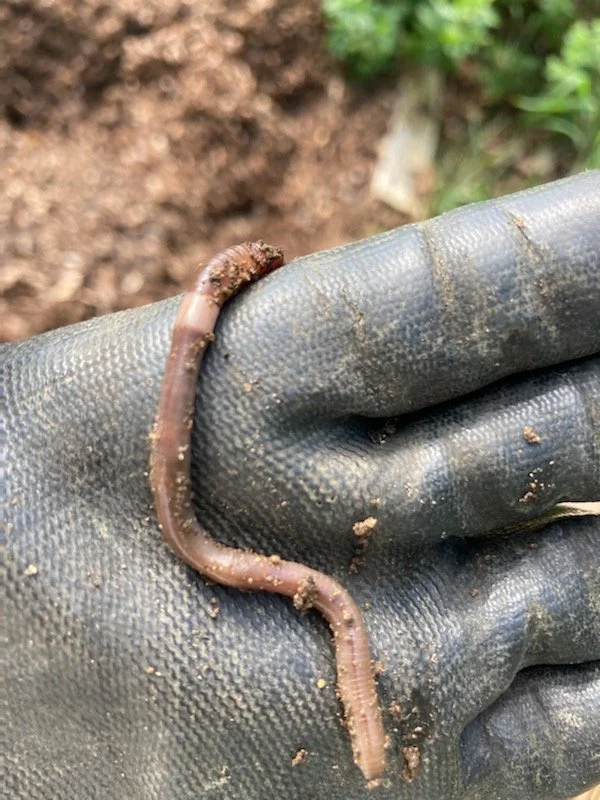Asian Jumping Worms
Harmful Invasive Jumping Worms Spread Mainly Through Gardening/Landscaping
This article was written with support and input from Hebron’s Conservation Commission
Gardening is a main way that the cocoons/eggs of jumping worms are being brought into the landscapes of local residents and businesses, even farms and open spaces. These cocoons can be brought in unobtrusively in soil, mulch, compost, leaves from infested areas, etc., as the cocoons can be as small and dark as poppy seeds. It only takes one cocoon to start a population of jumping worms. In addition, they do not all hatch in one year; they can take two years to hatch. The jumping worms themselves can spread 17 acres in a season, climb walls, cross wide areas of pavement...and there are no viable means to eradicate them once established.
Adult jumping worms differ from earthworms in that their clitellum (white band) completely encircles their body and is closer to their head. This is only visible late summer. But the main way adult jumping worms are noticed as "different" is that they move in a snake-like manner and very quickly.
Jumping worms are voracious eaters of all organic matter in the soil. Their castings are granular and easily wash away, leaving an area devoid of the soil needed by our native plants and trees to sprout or grow. This can be readily seen, for example, around previously mulched trees which now have bare roots exposed. Left unchecked, this would be devastating to forests and our whole ecosystem as plants are needed by animals, pollinators, and us. And forests are our ally in helping to fight the climate and biodiversity crises.
While the jumping worms themselves die in our winter climate, their cocoons survive even to temperatures of minus 39 degrees F, and thus survive our winters. It has been discovered that heat-treating cocoons to 105 degrees for 3 consecutive days will kill them; however, they survive forest fires since jumping worm castings are very insulating.
Helping to warn and educate others about preventing the transportation of cocoons in soils, mulch, and compost is important as this is the way we can help slow down/stop the spread of jumping worms, a serious threat to soils and the ecosystem.
The worms we see in the Spring are almost certainly not jumping worms. Regular earthworms survive through our winters, are not a threat, and are very different from the tropical jumping worms, which have to hatch from cocoons and start their growing cycle over each year.
Once adult jumping worms are discovered they have already been multiplying. Therefore, it is the prevention of bringing in jumping worm cocoons into new areas that is the best/only way to control the current rapid spread of these destructive worms. Prevention guidelines from the Connecticut Agricultural Experiment Station https://portal.ct.gov/-/media/CAES/DOCUMENTS/Publications/Fact_Sheets/Entomology/Jumping-worms-in-Connecticut.pdf are listed below:
Buy plants with bare roots, not in pots. Jumping worms are being distributed in potted plants. Check everything very carefully. If suspicious, wash root systems at home. [added note: Filter water with fine sieve to catch all solids. Place all solids in sealed plastic bag, place in hot sun for at least 10 minutes, then discard in trash.]
Avoid plant exchanges or sales.
Nursery staff should watch for worms by washing sample plant roots.
Propagate plants yourself from seeds or cuttings.
Do not share potted plants unless you are certain there are no jumping worms or wash the roots before planting. [see note above, 1st prevention tip, on filtering water, discarding all solids safely.]
Make your own compost.
Avoid purchasing compost unless the seller can prove that the compost has been heat-treated between 105°F and 131°F (40-55°C) for at least three days and there was no opportunity for trapped worms to flee to cooler areas of a compost pile during treatment.
Avoid purchasing mulch unless similar precautions have been taken.
Pay attention when bringing soil [or leaves] onto property. Worms, particularly juveniles and/or cocoons, can be carried in. [added note: make sure equipment, tires, and shoes are free of soil before entering or leaving property]
Do not buy worms for fish bait or vermicomposting unless you are certain there are no jumping worms. Many outlets have composting worm cultures that are contaminated with jumping worms. Do not buy on the internet.
Do not discard unused bait-worms on the ground or in water following fishing.
Do not move dead wood or wood mulch. Worms have been found under the bark of dead trees.
Do not use jumping worms as fish bait in remote natural habitats. They do not stay on the hook and fish don’t like them.
Do not dump infested yard waste in natural areas.
The Connecticut Agricultural Experiment Station Fact Sheets has more info on Jumping Worms online. The Fact Sheets can also be reached by visiting tinyurl.com/4zb2hb53

